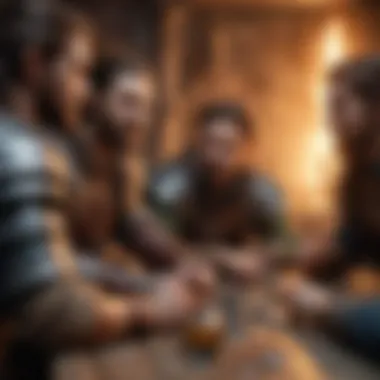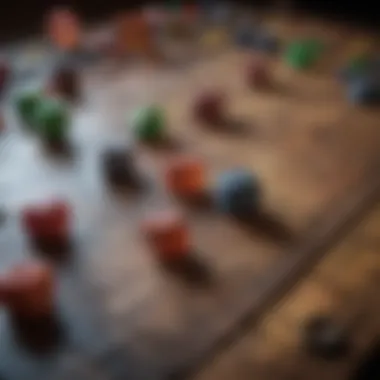Understanding Dungeons and Dragons Players: A Comprehensive Exploration


Intro
Dungeons and Dragons, often referred to as D&D, holds a significant place in the gaming world. This tabletop role-playing game started in the early 1970s and has evolved tremendously since then. The game blends imagination, storytelling, and social interaction, creating a platform unlike any other. Players immerse themselves in a fictional universe where they can explore, fight monsters, and build relationships with other characters and players.
The appeal of D&D spans generations. From its inception, it has attracted a diverse community of players, each with unique motivations. Some players seek adventure and the thrill of combat, while others enjoy character development and intricate storytelling. This article aims to understand these varied motivations and the dynamics within the D&D community.
With the resurgence of interest in tabletop games, this exploration holds relevance not only for long-time players but also for those curious about the game. Understanding the underlying factors that pull players into this complex world provides insight into broader societal trends.
As we proceed, we will examine key facets of D&D and its impact on players and culture, providing a comprehensive analysis that both avid fans and newcomers can appreciate.
The Rise of Dungeons and Dragons
The journey of Dungeons and Dragons, or D&D, is not merely about an intricate game but rather a significant cultural phenomenon that has reshaped storytelling, camaraderie, and imagination for decades. To understand the depth and breadth of its players, one must consider the origins and ascendance of this role-playing game. This rise is characterized by a blend of historical influences and cultural shifts, which collectively enrich the context in which D&D thrives today.
Historical Context
Dungeons and Dragons was first conceived in the early 1970s by Gary Gygax and Dave Arneson. Drawing inspiration from earlier wargames and fantasy literature, its initial release in 1974 marked the beginning of a new genre of gaming. The structure of gameplay encouraged collaborative storytelling and character development, setting it apart from traditional games.
The foundation of this game is rooted in a complex system of rules, dice rolls, and narrative choices, allowing players to embark on epic adventures together. This historical context is crucial for understanding the evolution of player engagement. Over the years, advancements in gaming technology and the internet facilitated easier access to D&D, enhancing community interaction and gameplay possibilities.
Cultural Impact and Popularity
D&D's influence spans multiple domains, solidifying its place in modern culture. Its rising popularity can be traced not only through sales figures but also through its integration into mainstream media. Television series, podcasts, and popular shows such as Stranger Things have showcased D&D, introducing the game to broader audiences.
The cultural significance of Dungeons and Dragons extends beyond entertainment; it fosters communal bonds and nurtures creativity. By engaging in rich narratives, players develop skills in problem-solving and teamwork. Additionally, the game serves as a platform for self-expression, enabling players to explore different facets of their identities through character creation and role-play.
"Understanding the rise of Dungeons and Dragons requires appreciation for its ability to create not just players but entire communities."
The combination of historical evolution and cultural integration has positioned D&D not just as a game but as a cultural artifact that reflects and shapes societal values. This rise creates a rich tapestry of player experiences that merits detailed exploration, helping us better understand the motivations behind participation and the implications of this unique form of engagement.
Profile of the & Player
Understanding the profile of a Dungeons and Dragons player is crucial for a deeper exploration of the game. The players bring a variety of backgrounds, motivations, and styles that enrich the overall experience of D&D. Recognizing these differences aids in appreciating the game’s diverse community and its evolving dynamics.
Demographics of Players
The demographics of D&D players have shifted over time, reflecting broader societal changes. Today, Dungeons and Dragons attracts a wide-ranging player base, crossing age, gender, and cultural boundaries. While it was once perceived primarily as a pastime for younger males, the landscape has broadended significantly. Recent studies show around 40% of D&D players are now women, highlighting the game's growing appeal.
Age demographics also vary, with many players ranging from teenagers to adults in their 50s. This diversity impacts gameplay, as younger players might seek more fast-paced sessions, while older players may prefer in-depth storytelling and character development. The rise of online platforms, such as virtual tabletops, allows players from different parts of the world to connect.
Some key elements of demographics include:
- Age: Different age groups approach the game with varying styles and expectations.
- Gender: Historically male-dominated, the inclusion of women is increasing.
- Cultural Background: Players bring diverse cultural perspectives, enriching the game's narratives.
Player Motivations
Understanding why individuals engage with Dungeons and Dragons is essential. Player motivations range from social interaction to creative expression. For many, these reasons intertwine, thus creating an engaging experience at the table.


Social interaction stands out as a primary motivation. D&D fosters connections and friendships through shared experiences. Players often enjoy collaborating on quests and character storylines, which strengthens their bonds. Creative expression is another important aspect; players can immerse themselves in character roles, narrate their unique stories, and explore imaginary worlds.
Additionally, motivations can be divided into categories:
- Escapism: Some players seek refuge from reality, immersing themselves in fantastical settings.
- Challenge: Problem-solving through gameplay provides satisfaction and achievement.
- Community Engagement: Many players are drawn to the community aspect, attending events or interacting in online forums, such as Reddit.
Understanding the profile of D&D players allows for a broader appreciation of the game’s impact, fostering a more inclusive environment.
Gameplay Dynamics
Gameplay dynamics are at the heart of Dungeons and Dragons, shaping the player experience and influencing how sessions unfold. Understanding these dynamics is essential for recognizing why players engage in the game and how their interactions develop over time. Key elements include play styles, session structures, and conflict resolution methods. Each aspect plays a vital role in establishing the atmosphere of the game and encouraging collaborative storytelling.
Play Styles and Preferences
The diversity of play styles among D&D players reflects their individual approaches to the game. Some players may prefer combat-driven gameplay, where tactical maneuvers and character abilities take center stage. Others might lean toward roleplaying, deeply immersing themselves in their character's thoughts and emotions. This variety impacts not only how players engage with the game but also how they collaborate with one another.
Knowing these preferences can enhance the overall group experience. Dungeon Masters can tailor sessions to fit their players' inclinations, whether they focus on intricate diplomatic negotiations or epic battles against formidable foes. Recognizing each player's style fosters an inclusive atmosphere where all voices can be heard.
Session Structures
The structure of D&D sessions can greatly influence gameplay dynamics. Each session generally follows a narrative arc, but variations exist based on player preferences and campaign goals. Sessions may range from single-story arcs to expansive, multi-session campaigns, each with its own rhythm and pacing.
Dungeon Masters often incorporate various techniques to keep players engaged:
- Cliffhangers to boost suspense.
- Character-driven storylines to develop personal arcs.
- World-building that invites exploration and interaction.
Being mindful of these structures can help balance gameplay. For instance, a session that is too combat-heavy may lead to fatigue, while a lack of action could cause disinterest. Understanding the desired session structure allows for adjustments that enhance immersion and enjoyment.
Conflict Resolution in Gameplay
Conflict resolution is a crucial aspect of D&D, as it not only governs character interactions but also shapes the narrative. Conflicts can arise within the party, between characters, or against external foes. The resolution methods used directly affect gameplay dynamics.
Ultimately, Dungeons and Dragons players engage with conflicts in several ways:
- Dice rolls - A fundamental mechanism that introduces chance and unpredictability.
- Roleplaying discussions - Essential for negotiating resolutions that make sense within the narrative framework.
- Creative problem-solving - Encouraged to find unique solutions to challenges.
Utilizing a balanced approach in conflict resolution strengthens the gameplay experience. It allows players to feel invested in their characters and the unfolding story. Comprehensive understanding of these dynamics ensures that all players remain actively involved and immersed in their adventures.
Understanding gameplay dynamics is vital for a richer and more effective interaction among players and between players and the game itself.
Community and Social Interactions
The interplay of community and social interactions significantly shapes the experience for Dungeons and Dragons players. Participating in the game often extends beyond mere gameplay; it encompasses a complex web of relationships that flourish both online and offline. Understanding these dynamics can provide insight into the motivations and behaviors of players, as well as the overall health of the community.
Online and Offline Communities
In recent years, the rise of online platforms has revolutionized how players connect. Websites like Reddit offer forums where players can discuss strategies, share stories, and form virtual friendships. Social media platforms like Facebook also allow groups centered around D&D to flourish, enabling players to collaborate and share experiences in real-time. This digital engagement reduces geographical barriers and fosters a sense of belonging among players from diverse backgrounds.


However, offline communities still hold significant importance. Local game shops often serve as gathering places where players can find groups or attend sessions. Participating in these environments helps forge deep connections, which can enhance the emotional and social experience of the game. Players often form bonds that extend outside the game, leading to friendships that endure over time.
The duality of online and offline interactions enriches the player experience, combining convenience with personal connection. Furthermore, this enables the exchange of creative ideas, stories, and even gameplay mechanics, contributing to a constantly evolving understanding of D&D.
"The community is as essential to D&D as the rules themselves. It’s the interactions with others that often make or break the gaming experience."
Events and Gatherings
Events and gatherings are pivotal in fostering community ties among Dungeons and Dragons enthusiasts. From local game nights at shops to major conventions like Gen Con, these events provide invaluable opportunities for players to engage with one another face-to-face.
These gatherings serve several purposes:
- Networking: Players meet others who share their interests, possibly leading to new gaming groups.
- Skill Sharpening: Participants can learn from one another, whether through watching experienced Dungeon Masters or joining one-shot sessions.
- Cultural Exchange: Events often introduce players to unique styles of gameplay or character creation, broadening their scope of understanding.
- Celebration of Creativity: These occasions often showcase homebrew content, allowing players to demonstrate their imaginative contributions to the game.
Overall, the significance of community and social interactions in Dungeons and Dragons cannot be overstated. The interplay between online and offline elements, coupled with shared events, underscores the collaborative spirit that defines the game. Understanding these social dynamics enriches appreciation for how deep-rooted connections enhance overall player engagement.
Psychological Aspects of Playing &
Understanding the psychological aspects of playing Dungeons and Dragons reveals why this game resonates deeply with its players. It is more than mere entertainment; it taps into significant cognitive and emotional experiences. By examining these facets, one gains insight into the underlying motivations, relationship dynamics, and overall benefits of engaging with this role-playing game. Players often develop a strong affiliation with their characters, which influences their emotional and cognitive processes within and outside the game context.
Cognitive Benefits
Dungeons and Dragons offers various cognitive benefits that contribute to greater mental agility. Engaging with complex rules and scenarios stimulates critical thinking. Players must analyze situations, strategize solutions, and make decisions in a semi-controlled environment. This problem-solving element encourages creative thinking, enhancing players’ abilities to navigate real-life situations.
Some key cognitive benefits include:
- Improved Analytical Skills: Players must assess their strengths and weaknesses constantly while evaluating threats or opportunities. These analytical processes improve their strategic foresight.
- Enhanced Memory: Keeping track of diverse characters, spells, abilities, and rules cultivates a stronger memory. Players often have to recall detailed lore, enhancing their recall skills.
- Social Intelligence Development: Player interactions require understanding social cues and group dynamics. This leads to sharper interpersonal skills and improves real-world communication.
Emotional Engagement
Emotional engagement is a profound aspect of the Dungeons and Dragons experience. The game encourages players to invest emotionally in both their characters and fellow players. This investment cultivates a sense of belonging and camaraderie, which is essential for community building.
Key elements of emotional engagement in D&D include:
- Character Identification: Many players feel a strong connection to their characters. This identification can serve as a form of self-exploration and personal expression, enabling players to navigate their emotions through the lens of their characters’ journeys.
- Shared Storytelling: The narrative component of D&D fosters collaboration. Players collectively create stories, establishing meaningful connections and shared experiences that linger well beyond the game session.
- Safe Space for Expression: D&D provides a platform for emotional exploration within a safe environment. Players can experience joy, fear, and vulnerability without real-life repercussions, allowing them to confront various issues or themes in a supportive context.
Playing D&D is more than just rolling dice; it’s about forging connections and developing a deeper understanding of ourselves and others.
Dungeons and Dragons in Modern Culture
Dungeons and Dragons holds a significant place in modern culture, shaping not only gaming but also influencing storytelling across various media. This section examines the numerous ways in which D&D has integrated into contemporary society, exploring aspects such as media representation and its impact on other game genres. The cultural relevance of Dungeons and Dragons is evident in its ability to transcend its original framework, attracting a diverse audience and fostering community through shared experiences.
Media Representation
Media representation of Dungeons and Dragons has evolved dramatically over the years. Initially, the game faced scrutiny and was often misconstrued as merely a niche pursuit for a specific demographic. However, in recent years, D&D has become more mainstream, partly due to its portrayal in popular television series and films. The show "Stranger Things" serves as a pivotal example, using D&D to symbolize friendship, imagination, and the struggles of adolescence. This representation helps to normalize the game, drawing new players and rekindling interest among seasoned gamers.
Furthermore, various online platforms, including Twitch and YouTube, have highlighted D&D gameplay through live-streamed sessions and recorded campaigns. Popular shows, such as "Critical Role," showcase professional voice actors playing D&D, further elevating its profile. The engaging nature of these representations not only entertains but also educates viewers about the complexities and joys of the game.


Influence on Other Game Genres
Dungeons and Dragons has undeniably influenced numerous other gaming genres. Its foundational mechanics, such as role-playing elements and narrative-driven gameplay, can be seen in many popular video games and tabletop RPGs today. Titles like "The Elder Scrolls" and "World of Warcraft" borrow heavily from D&D’s emphasis on character customization, storytelling, and immersive worlds.
Moreover, the D20 system, introduced in D&D, has been adopted by various gaming systems, allowing players to engage in diverse and dynamic gameplay experiences. The rise of hybrid board games, which combine elements of traditional board gaming with role-playing components, can be directly traced back to D&D's impact.
In summary, the importance of Dungeons and Dragons in modern culture goes beyond just gameplay mechanics. It serves as a cultural touchstone, fostering community and creativity. The ongoing media representation reinforces its relevance, while its influence reshapes how games are developed and enjoyed across the globe.
Challenges and Misconceptions
In exploring Dungeons and Dragons (D&D) players, one can not overlook the prevalent challenges and misconceptions surrounding the game. These challenges impact player experiences and the broader perception of the community. Addressing such issues is crucial for fostering an inclusive culture and enhancing understanding of the game. Societal stereotypes and the concerns about gaming addiction contribute to a skewed image of D&D, often leading to untruths that can discourage potential players from engaging with the game.
Societal Stereotypes
Societal stereotypes often paint D&D players in a narrow frame. The notion of players as socially awkward or living in a fantasy world is widespread. These stereotypes can stem from media portrayals or misunderstandings of the game mechanics. Furthermore, the history of D&D includes portrayals of it being linked to negative behaviors or criminal activities. This has created a stigma.
Such misunderstandings ignore the diversity within the player base. In reality, D&D attracts individuals of various backgrounds, professions, and interests. Many players are skilled communicators and leaders. They engage in teamwork and develop complex narratives that require collaboration. The real challenge is reshaping the narrative around D&D.
Players often describe the enjoyment of the game as a mix of creativity and camaraderie, and the stereotypes do a disservice to these experiences. Addressing these stereotypes requires open discussions about the game’s benefits and impact on social skills, creativity, and problem-solving abilities.
Addressing Concerns about Gaming Addiction
Another significant concern relates to gaming addiction. Critics argue that immersive games like D&D foster compulsive behaviors. Yet, these concerns merit a nuanced view. D&D is fundamentally different from many digital games that can contribute to addiction. Players often gather for scheduled sessions, which can help establish healthy boundaries around gameplay.
Moreover, the game encourages social interactions and can even facilitate mental health benefits. While excessive engagement can be an issue in any hobby, the majority of players exhibit a balanced approach. They participate in D&D as a means of escape and a form of relaxation.
Addressing these concerns involves emphasizing responsible gaming practices. Encouraging players to maintain a balance between their D&D sessions and other activities is essential. Information from sites like Wikipedia provides insight into responsible gaming. Communities, including platforms like Reddit, often share personal stories demonstrating the positive influence of D&D on their lives.
The Future of Dungeons and Dragons Player Engagement
The evolution of Dungeons and Dragons continues to shape how players connect and engage with the game. As the landscape of gaming progresses, understanding the future of D&D player engagement becomes crucial. This section highlights several pivotal elements that will affect players and their interactions with the game in coming years.
Trends in Player Technology
Technology has become an integral part of the Dungeons and Dragons experience. With the rise of online platforms, virtual tabletops and mobile applications are changing how sessions are conducted. Tools like Roll20 and D&D Beyond enable players to connect regardless of physical location. This connectivity has broadened the player demographic. It encourages participation from various regions and backgrounds, fostering a more diverse community.
Moreover, advancements in augmented reality and virtual reality stand to further transform gameplay. Imagine donning a VR headset and immersing in a digital dungeon, interacting with characters and environments in real-time. Such innovations not only enhance the aesthetic experience but also deepen player investment in the narrative.
The importance of these trends cannot be overstated. Players can have greater accessibility to resources and communities. This enables them to play more frequently and experiment with different styles of play. The integration of technology will likely lead to gamified elements in character creation and storytelling, which could enrich the overall narrative experience in future gameplay.
Evolving Gameplay Mechanisms
As Dungeons and Dragons progresses, gameplay mechanisms are also likely to evolve. Game designers are exploring new methods to enhance interactivity and storytelling. Providing players with unprecedented choices in how their characters evolve is also a distinct possibility.
Incorporating feedback from diverse player communities can lead to adaptations that better serve varying interests. This can reflect in aspects like open-ended quests and modular rule sets that allow for flexibility based on player types. Mechanics that focus on collaborative storytelling rather than competitive gaming may emerge as well, promoting teamwork and shared experiences.
There is also consideration for the integration of more inclusive gameplay systems. D&D is already seeing positive changes in its approach to representation and character development. Future mechanisms may focus on ensuring that all players find aspects that resonate with them, ensuring broader appeal.
To summarize, the trends in player technology and evolving gameplay mechanisms reveal an exciting future for Dungeons and Dragons. The potential adaptations stand to foster a more inclusive and engaging experience.
"As technology integrates more into the gameplay, the essence of Dungeons and Dragons—the art of storytelling—will remain central to its appeal."
As we look towards the future, this balance between tradition and innovation will be essential in retaining the core values of the game while attracting new players.







